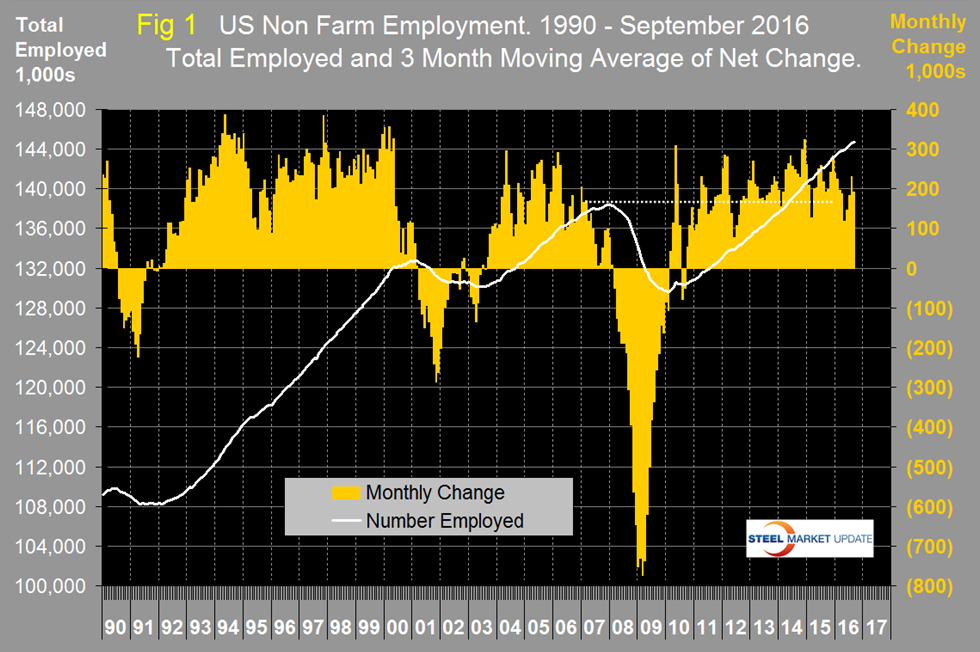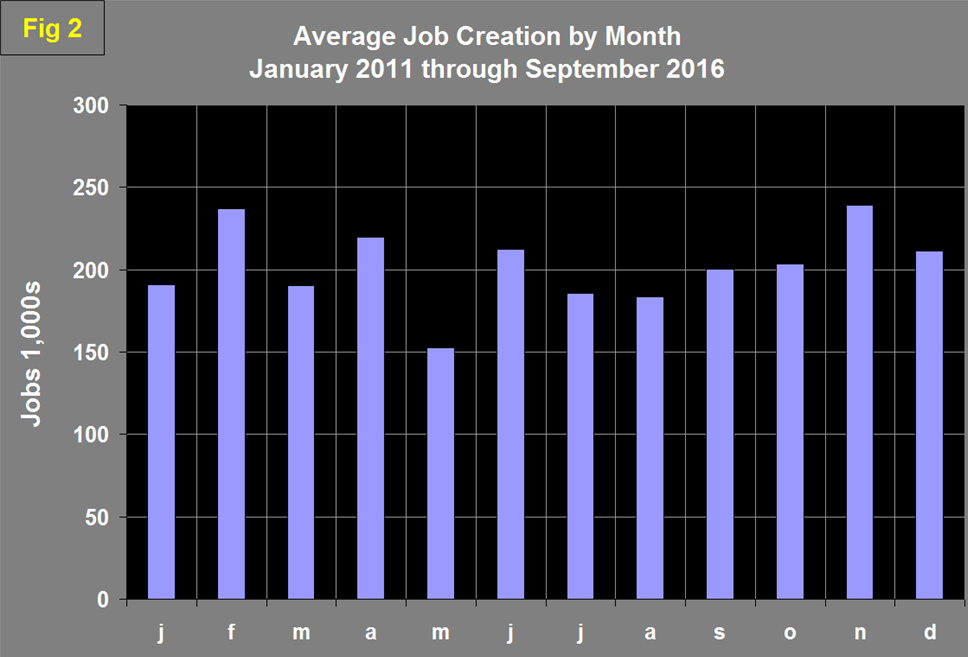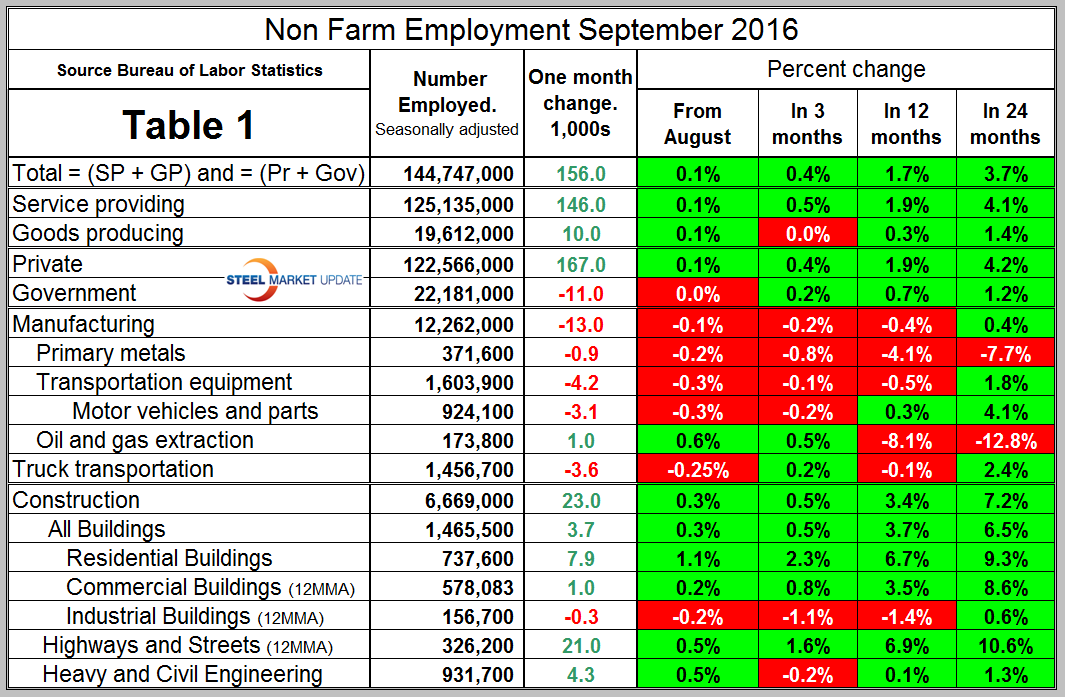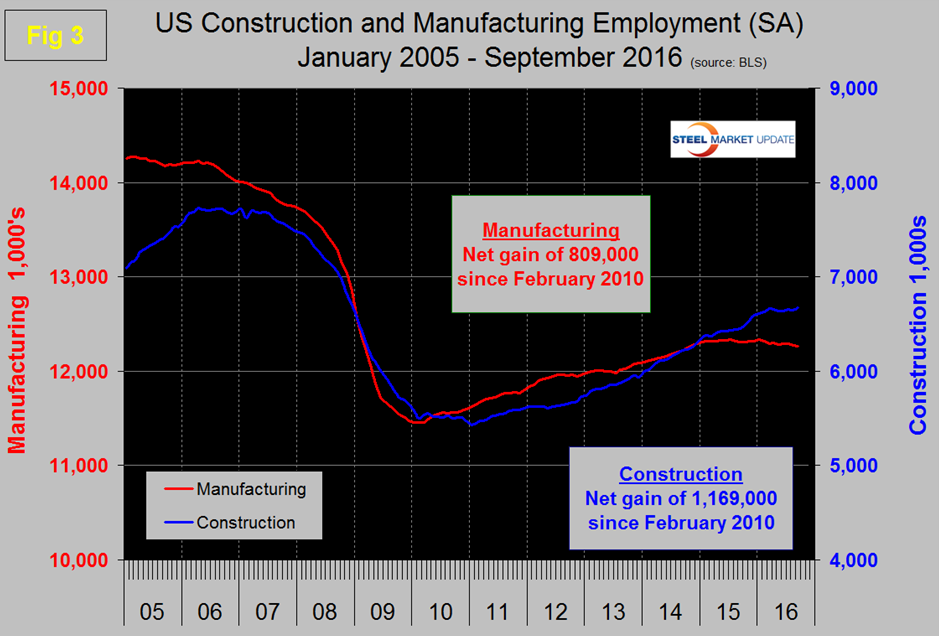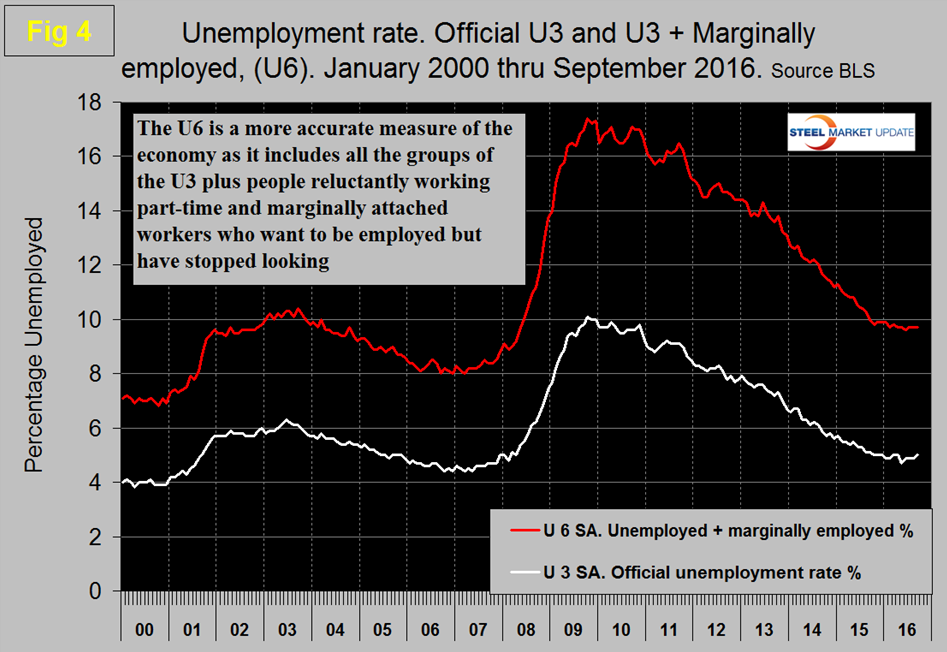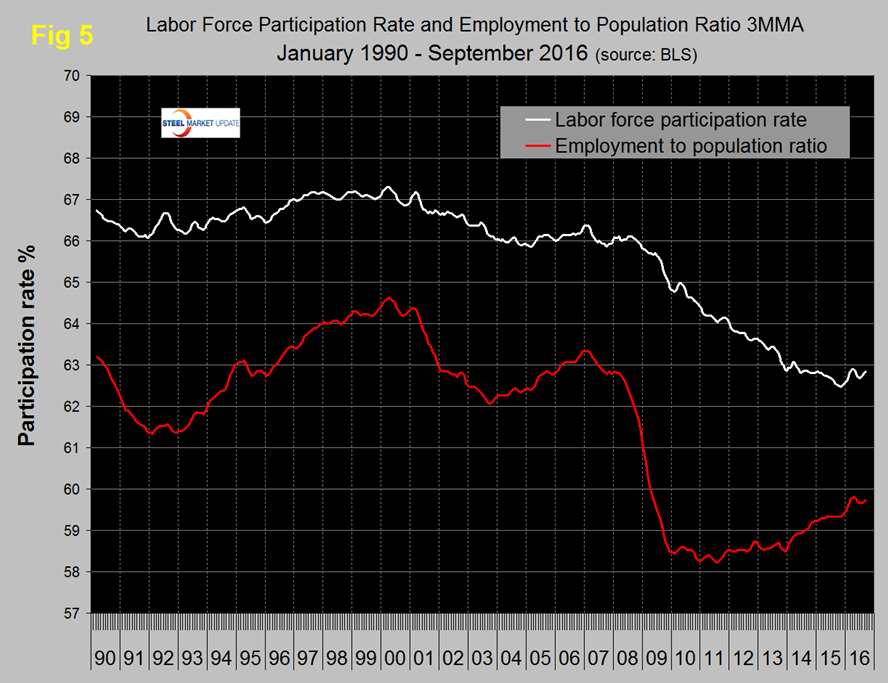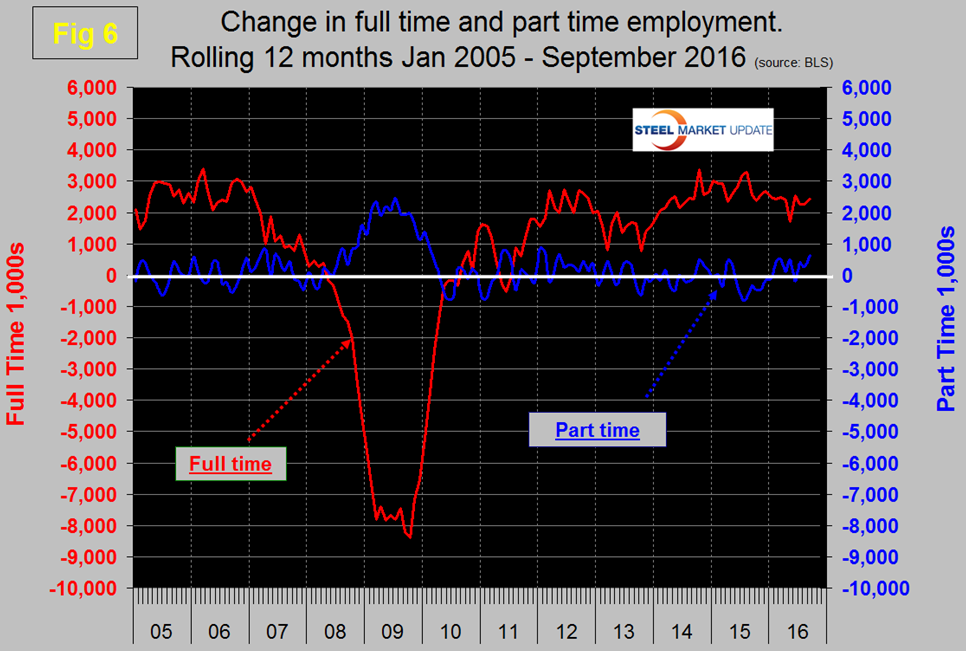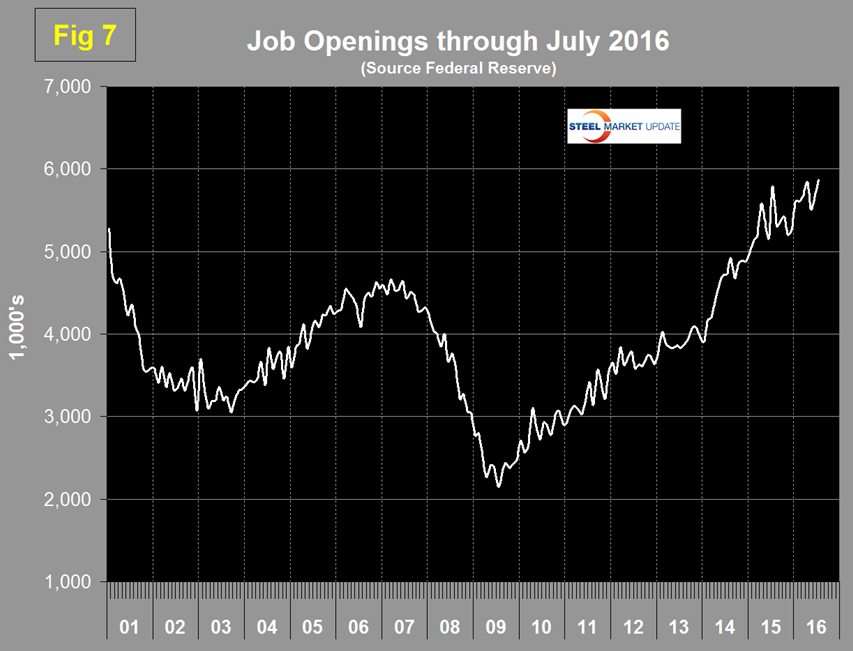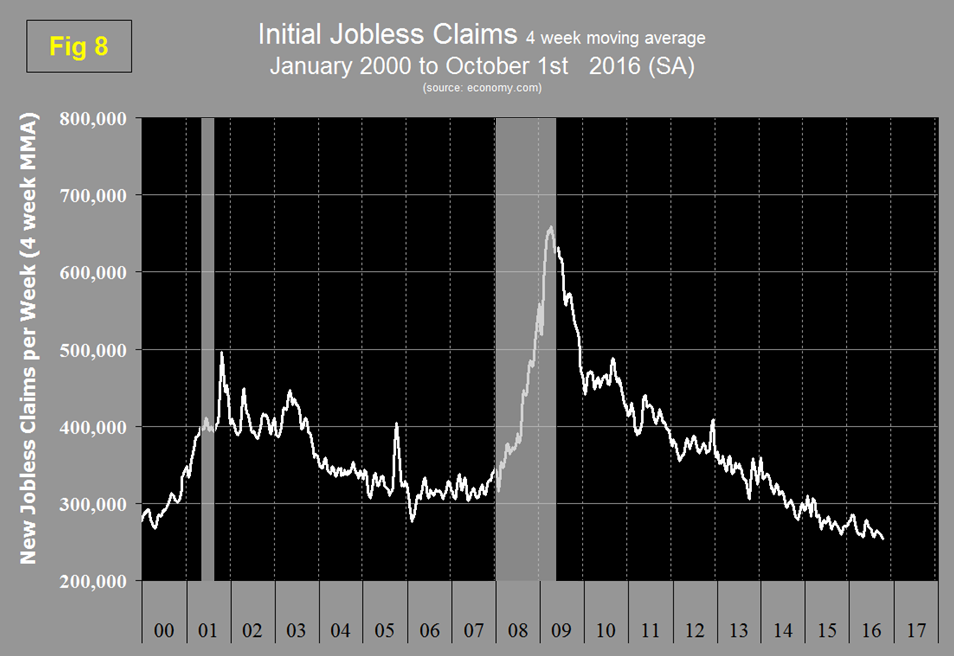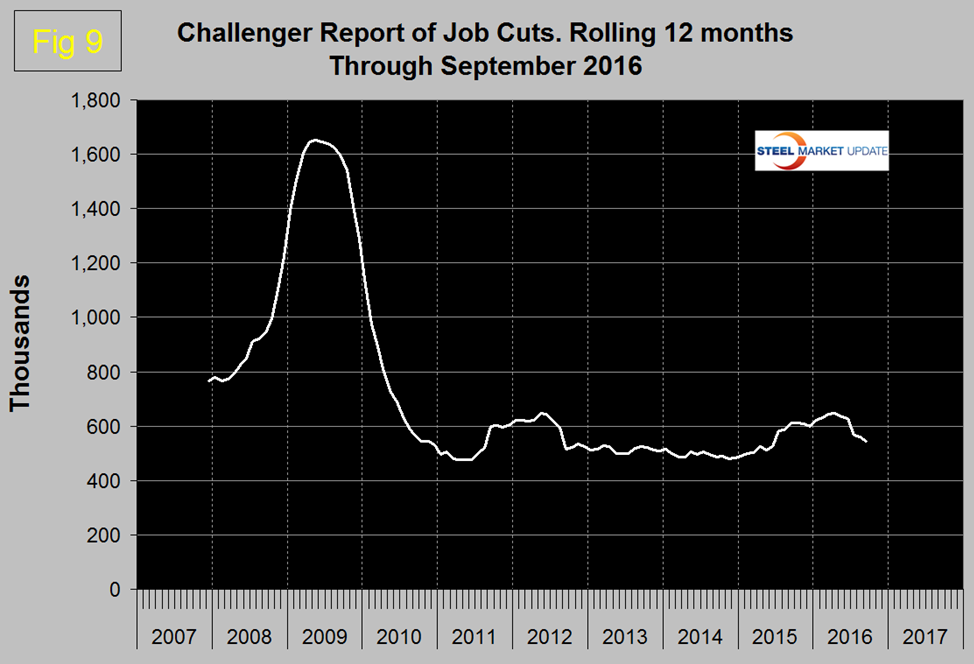Market Data

October 11, 2016
Net Job Creation by Industry through September 2016
Written by Peter Wright
In September net job creation was 156,000 July was revised down by 23,000 and August revised up by 16,000. Using a 3MMA, the result for September was 192,000 down from 230,000 in August. Figure 1 shows the 3MMA of the number of jobs created as the brown bars since 1990.
These numbers are seasonally adjusted by the BLS so to examine if any seasonality is left in the data after adjustment we have developed Figure 2.
Evidently the seasonal adjustment is less than perfect. In the six years since and including 2011, September job creation has been up by 9.3 percent. This year September was down by 6.6 percent therefore this is a disappointing result. Total nonfarm payrolls are now 6,382,000 more than they were at the pre-recession high of January 2008.
Table 1 slices total employment into service and goods producing industries and then into private and government employees.
Total employment equals the sum of private and government employees, it also equals the sum of goods producing and service employees. Most of the goods producing employees work in manufacturing and construction and the components of these two sectors that we consider to be of most relevance to steel people are broken out in Table 1. In September, 167,000 jobs were created in the private sector and government lost 11,000. The Federal government gained 4,000 as local governments lost 15,000. This was the first month for local governments to cut employment since November last year. State government’s employment total was unchanged. Since February 2010, the employment low point, private employers have added 15,309,000 jobs as government has shed 295,000. In September, service industries expanded by 146,000 and goods producing industries by 10,000 people. Since February 2010, service industries have added 13,029,000 and goods producing 1,985,000 positions. This is part of the reason for stagnant wage growth since service industries on average pay less than goods producing such as manufacturing.
In September, manufacturing lost 13,000 jobs and for the year as a whole is down by 58,000. August and September had a combined loss of 29,000 following small gains in June and July. In September total manufacturing employment was 0.4 percent less than a year ago but 0.4 percent higher than two years ago. Primary metals have had only one month of positive job growth in the last 20 months and have lost 4.1 percent in the last year and 7.7 percent in two years. Table 1 shows that in September oil and gas extraction had an employment gain of 1,000 people following the same gain in August. These last two months were the first back to back months of gains since September and October 2014. Truck transportation lost 3,600 positions in September and is down by 7,100 YTD. Note the subcomponents of both manufacturing and construction shown in Table 1 don’t add up to the total because we have only included those that we think have most relevance to the steel industry.
Construction was reported to have gained 23,000 jobs in September and is up by 72,000 YTD. The construction employment data is not as positive as the construction expenditures report (CPIP) issued by the Department of Commerce. This maybe, as the Associated General Contractors of America continue to report, because of a lack of availability of skilled workers which is being ameliorated by longer work weeks.
Some of the major construction sub categories are routinely reported one month in arrears which distorts the data in Table 1. These include, industrial buildings, commercial buildings and highways and streets. Construction has added 1,169,000 jobs and manufacturing 809,000 since the recessionary employment low point in February 2010 (Figure 3).
Construction has leapt ahead of manufacturing as a job creator but the growth of construction productivity is very low (or non-existent), in contrast to manufacturing where it is very high. The difference is the difficulty of automating construction jobs.
The official unemployment rate, U3, calculated from a different survey, increased from 4.9 percent in August to 5.0 percent in September. This number doesn’t take into account those who have stopped looking. The more comprehensive U6 unemployment rate has been unchanged at 9.7 percent since and including July (Figure 4).
U6 includes workers working part time who desire full time work and people who want to work but are so discouraged that they have stopped looking. The differential between these rates was usually less than 4 percent before the recession but is still 4.7 percent.
The employment participation rate is widely quoted in the press as going nowhere. In September 2016 the rate was 62.9 percent, with a 3MMA also of 62.8 percent. There was a small improvement from 62.4 percent in September last year to 63.0 percent in March but no progress since then. We’re not sure that we understand what this is a percentage “of” because of the multiple descriptions of the labor pool. Another measure is the number employed as a percentage of the population which we think is much more definitive. In September this measure was up by 0.1 percent at 59.8 percent with a 3MMA of 59.7 percent. There has been a gradual improvement in employment to population ratio since late 2011. Figure 5 shows both measures on one graph.
In the 21 months since and including January 2015 there has been an increase of 4,362,000 full time and a gain of 131,000 part time jobs. Figure 6 shows the rolling 12 month total change in both part-time and full-time employment.
Frequently in the press we read that a large part of job creation is in part-time employment which in some months is true but the part-time numbers are extremely volatile. To overcome the volatility we have to look at longer time periods than a month or even a quarter which is why we look at a rolling 12 months for this component of the employment picture.
The job openings report known as JOLTS is reported on about the 10th of the month by the Federal Reserve and is over a month in arrears. Figure 7 shows the history of unfilled job openings through July when openings stood at 5,871,000 an all-time high. There has been an improving trend throughout 2016.
Initial claims for unemployment insurance, reported weekly by the Department of Labor have continued their downward drift this year and in w /e October 1st were 253,500 on a four week moving average basis. This marks the longest streak since 1973 of initial claims below 300,000. (Figure 8).
The last piece of the employment puzzle that we examine is the Challenger report which measures job cuts monthly (Figure 9).
This data also tends to be quite erratic therefore again we examine a rolling 12 months and can see that job cuts increased from late 2014 through April this year and have declined for the last five months.
![]() SMU Comment: The employment picture is mixed. September was the 71st consecutive month of job growth but it looks as though a slowdown is occurring. September data for manufacturing was disappointing and for construction was encouraging. In the big picture, layoffs are still declining and job openings are increasing therefore there seems to be no reason for pessimism.
SMU Comment: The employment picture is mixed. September was the 71st consecutive month of job growth but it looks as though a slowdown is occurring. September data for manufacturing was disappointing and for construction was encouraging. In the big picture, layoffs are still declining and job openings are increasing therefore there seems to be no reason for pessimism.
Explanation: On the first Friday of each month the Bureau of Labor Statistics releases the employment data for the previous month. Data is available at www.bls.gov. At SMU we track the job creation numbers by many different categories. The BLS data base is a reality check for other economic data streams such as manufacturing and construction and we include the net job creation figures for those two sectors in our “Key Indicators” report. It is easy to drill down into the BLS data base to obtain employment data for many sub sectors of the economy. For example, among hundreds of sub-indexes are truck transportation, auto production and primary metals production. The important point about each of these hundreds of data streams is in which direction they are headed. Whenever possible we at SMU try to track three separate data sources for a given steel related sector of the economy. We believe this gives a reasonable picture of market direction. The BLS data is one of the most important sources of fine grained economic data that we use in our analyses. The States also collect their own employment numbers independently of the BLS. The compiled state data compares well with the federal data. Every three months SMU examines the state data and provides a regional report which indicates strength of weakness on a geographic basis. Reports by individual state can be produced on request.



